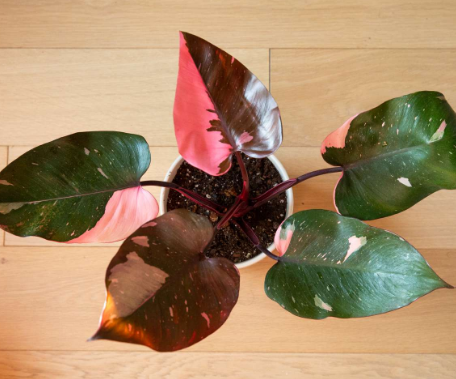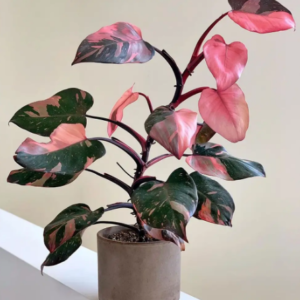The Pink Princess Philodendron: A Regal Addition to Your Indoor Plant Collection

It is the Pink Princess Philodendron, scientifically identified as Philodendron rubescens “Pink Princess,” is an amazing version of the iconic philodendron which has won the imagination of gardeners all over the world. The distinctive pink hue with dark-green leaves make it a sought-after plant in the world of plants. This article is a thorough information on caring for and understanding Pink Princess Philodendron, helping you to maintain this stunning species flourishing in your house.
Characteristics of the Pink Princess Philodendron
Appearance
The most noticeable feature to The most striking feature of Pink Princess is its leaves. Each leaf is distinct that is adorned with bright red and deep green. The strength and the pattern of pink hues may differ in each leaf even within the same plant. This enhances the appeal of. Young leaves generally begin with a deep, burgundy-colored color then gradually turn hue of pink and green when they get older.
Growth Habit
The plant is a climber type, meaning it thrives desirable by together a moss rod or trellis for support of the vines. When it’s in good conditions, it will grow up to four feet tall, but the plant is typically smaller when it is grown in inside.
Care Guide

Light Requirements
Its Pink Princess Philodendron thrives under the bright indirect lighting. A lot of direct light can cause its leaves to burn, and the absence of light may result in the vivid pink variations to diminish. The north or east-facing windows can be ideal for achieving an ideal balance of lighting.
Watering
It is essential to water the overall health of the plant. It is essential to keep the soil always moist, but not drained. The upper inch of soil to dry before applying water again in order to avoid excessive watering that can cause root decay. In the winter cut down on watering when the plants’ growth slows.
Humidity and Temperature
Philodendrons like higher levels of humidity that range from 60% to the 80% mark. If the environment is dry humidifiers can benefit achieve this goal and you could also place an ice tray next to the plant in order to rise the humidity. Place the plant within a warm and comfortable environment. temperatures ranging from 65degF to 75degF (18degC up to 24degC) are ideal.
Soil and Fertilization
Utilize a potting mix with a good drainage made for aroids. You can also make your own mix by mixing ordinary potting mix with peat moss and perlite. Fertilize your Pink Princess monthly during the time of the growing season using the right balance of water-soluble fertilizer that is diluted by half of the strength recommended. Avoid fertilizing during winter, when the growth of the plant naturally decreases.
Pruning and Maintenance
Pruning isn’t usually required however it can help form the plant or to encourage growth, which could cause a rise in variegation. Use clean, sharp pruning tools to prevent damaging the plant.
Propagation
Growing The Pink Princess is relatively straightforward. The accurate method is to use cuttings of the stem. Choose a healthy portion of stem that has at the very least one node (a little lump on the stem at which new leaves appear). Cut just beneath the node and then place the cut in some water or in moist soil. Roots will begin to grow in the next few weeks.
Common Issues
Pests
Watch out for pests that are commonplace, such as mealybugs, aphids as well as spider mites. Get rid of infestations as early as possible with Neem oil or soap for insecticides.
Variegation Loss
If you notice that your plant is beginning to fade its pink color it could result from inadequate lighting. Try moving it to a more bright area that doesn’t have the direct light.
Why is pink philodendron that expensive?
It is known as the Pink Princess Philodendron is notably costly due to its striking pink color, which is sought-after by collectors and plant lovers. The rarity of this variety is caused by genetic changes, which make each leaf distinctively patterned the colors of green and pink. The slow rate of growth for this variety, known as the Pink Princess, combined with the specific requirements for care as well as its limited growth success also limit its use within the marketplace. Since demand is continuing to exceed supply, the costs for these stunning plants are expensive, making them an expensive item in the community of home plants.
Do you think philodendron pink princess is difficult to take care of?
Care for an Philodendron Pink Princess can be slightly challenging, because it requires certain environmental conditions that will benefit maintain the distinctive pink color. It requires bright and indirect sunlight to maintain its distinctive color Insufficient light could make the colors diminish, and the excessive exposure to direct sunlight could cause damage to the leaves.
A steady level of moisture without waterlogging as well as high humidity and hot temperatures are vital to assure the health of your plant. Additionally, the plant’s slower growth rate as well as susceptibility to pests such as aphids and spider mites contribute to the difficulty in caring for it. So, although it’s not one of the easiest to care for plant, Pink Princess Pink Princess does require a little more care and attention in comparison to other species of philodendrons.
How can I turn my pink princess philodendron look pink?
To maintain and enhance the pink hue of Your Pink Princess Philodendron, help in providing the plant with bright and indirect sunshine. This is vital since it helps to produce the pink pigment that is present in the leaves. But direct sunlight must be avoided since it could cause scorching to the leaves.
It is essential to assure that your plant has an abundant supply of nutrients and a well-drained soil mix that is maintained within a steady moisture level and not becoming overly waterlogged could help to maintain its overall vitality and health. Pruning regularly old or less variegated leaves will help encourage the growth of brand new and possibly more vibrantly pink leaves. This can increase the visual appeal that you can get from the Pink Princess.
What amount of light will a pink Princess Philodendron require?
It is the Pink Princess Philodendron thrives in the indirect, bright lighting that promotes its distinct color and overall wellbeing. It is best located near a window which gets plenty of sunlight however is protected from brutal direct sunlight of sun. For instance, it should be placed in the shade of sheer curtains, or off from windows facing south. The lighting that it receives is able to create vivid color without causing burning leaves. If you’re not getting suitable natural light then you should consider adding artificial grow lights. Make sure they’re located in the appropriate distance so that they mimic the natural lighting conditions.
Conclusion
This Pink Princess Philodendron is a real gem to have in any outdoor garden. When properly maintained it is sure to add some elegant elegance to your house. Its distinctive appearance and bright shades make it an enjoyable task for both experienced and novice gardeners of all levels. Take advantage of the excitement of growing this Pink Princess and enjoy the beautiful, vibrant aesthetics it will bring to your garden collection.


